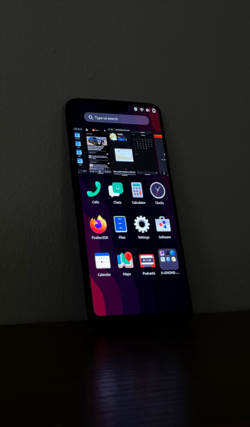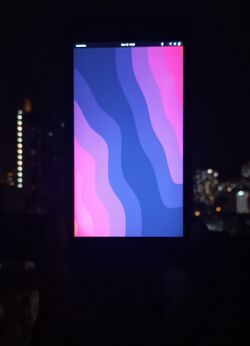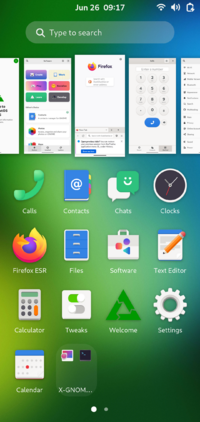GNOME: Difference between revisions
→GNOME Mobile: add upstream links |
|||
| (43 intermediate revisions by 14 users not shown) | |||
| Line 1: | Line 1: | ||
GNOME | {{Infobox interface | ||
|name=GNOME | |||
|image=File:GNOME_screenshot.png | |||
|imagecaption=GNOME activity page | |||
|graphics=Mutter | |||
|toolkit=Clutter | |||
|package = postmarketos-ui-gnome | |||
}} | |||
[[Wikipedia:GNOME|GNOME]] (/(ɡ)noʊm/) is a user Interface that aims to be simple and easy to use. It is designed by [[Wikipedia:The GNOME Project|The GNOME Project]] and is composed entirely of free and open-source software. The following variants are available in postmarketOS: | |||
* '''GNOME''', the default, runs traditional GNOME Shell mosten used on the desktops or laptops. | |||
GNOME | * '''GNOME Mobile''' are patchsets on top of the GNOME stack, that make GNOME suitable for mobile phones and touch devicse. | ||
{{UI_init|only_systemd=true}} | |||
During pmbootstrap init you can choose either <code>gnome</code> (the stock GNOME shell) or <code>gnome-mobile</code> (with mobile patches). | |||
=== | == GNOME Mobile == | ||
{{Infobox interface | {{Infobox interface | ||
| name = | | name = GNOME Mobile (Experimental) | ||
| image = File:Gnome mobile. | | image = File:Gnome-mobile-postmarketos-23.06.png | ||
| imagecaption = Gnome Shell w/ mobile patches running on | | imagecaption = Gnome Shell w/ mobile patches running on Oneplus 6 | ||
| graphics = Mutter | | graphics = Mutter | ||
| toolkit = Clutter | | toolkit = Clutter | ||
| Line 24: | Line 28: | ||
}} | }} | ||
GNOME is a fairly adaptive user interface, however GNOME is not very comfortable to use on a phone because of their lack of touchscreen gestures. Many developers (especially Jonas Dreßler) have been working on this and [https://blogs.gnome.org/shell-dev/2022/09/09/gnome-shell-on-mobile-an-update/ developed a prototype]. The patches are very work-in-progress and not all of them are upstream yet, however it's being worked on. | |||
[[File:Gnome-shell-mobile-running-on-oneplus-6.png|250px|thumb|postmarketOS with GNOME Mobile on the OnePlus 6]] | |||
=== | === Troubleshooting === | ||
* | ==== Scaling ==== | ||
* | The scaling is sometimes set to 200 %, which will keep Gnome in desktop mode (and not in mobile mode). There are 2 ways to set the display scale: | ||
* Normal way: Change '''Settings''' > '''Display''' > '''Scale''' to 300%. | |||
* Hacky way: Open '''~/.config/monitors.xml''' in editor and set '''scale''' to 3 then reboot or relogin | |||
* Hacky way 2: Remove '''~/.config/monitors.xml''', run '''gsettings set org.gnome.desktop.interface scaling-factor 3''' then relogin. | |||
On some devices or on newer versions of gnome there is no 300% scaling option in settings. | |||
==== Firefox issues under Wayland ==== | |||
On gnome-mobile Firefox doesn't use wayland for rendering. | |||
It causes some issues: | |||
* Scaling issue: Firefox runs in a low-resolution mode and looks ugly. | |||
* Input issue: Firefox doesn't trigger the gnome OSK | |||
Solutions to these issues can be found below: | |||
[https://wiki.postmarketos.org/wiki/Firefox#Scale_and_keyboard_on_wayland_desktop_environments here] | |||
=== Bug reporting === | |||
This is under active development and has many known and unknown bugs. It is packaged here in order to be a development target. '''Please report the issues to postmarketOS before filing upstream''', as at this early stage it is unknown whether potential bugs may be due to packaging or in the code upstream. | This is under active development and has many known and unknown bugs. It is packaged here in order to be a development target. '''Please report the issues to postmarketOS before filing upstream''', as at this early stage it is unknown whether potential bugs may be due to packaging or in the code upstream. | ||
=== See also === | === See also === | ||
* {{MR|3404|pmaports}}: initial MR | * {{MR|3404|pmaports}}: initial MR | ||
* [https://gitlab.gnome.org/verdre/gnome-shell-mobile gnome-shell-mobile GitLab] | |||
* [https://gitlab.gnome.org/verdre/mutter-mobile mutter-mobile GitLab] | |||
* [https://gitlab.gnome.org/verdre/gnome-settings-daemon-mobile gnome-settings-daemon GitLab] | |||
== Extensions == | |||
* '''Force phone mode''' — Forces gnome-mobile to use phone mode. Without it, phone mode will be calculated by screen resolution and scale factor '''(gnome-mobile only)'''<br />https://github.com/vixalien/force-phone-mode | |||
* '''Screen auto rotate button''' — GNOME supports automatic screen rotation, but on a phone it is often useful to switch between manual/automatic rotation on the fly. This adds a button to the system status area.<br/>https://github.com/shyzus/gnome-shell-extension-screen-autorotate | |||
* '''Screen manual rotate button''' — On phones without support for the gyroscope the following extension adds just a button to manually rotate the screen instead<br/>https://gitlab.gnome.org/gnumdk/add-rotate-button | |||
* '''Clock to the left''' — Many phones/mobile devices have a notch that makes it necessary to move the clock on the notification bar to the left side<br/>https://gitlab.gnome.org/gnumdk/move-shell-clock/ | |||
* '''Flashlight button''' — Adds a button to to turn on the device flashlight in Quick Settings (see [[LEDs|LEDs]] for more details)<br/>https://github.com/vixalien/gnome-mobile-torch | |||
| | * '''Hide Volume Indicator''' — Removes the useless volume indicator in the top bar<br/>https://codeberg.org/stephaniebread/gnome-hide-volume-indicator | ||
* '''Privacy Quick Settings''' — Add privacy settings toggles to the GNOME system menu<br/>https://extensions.gnome.org/extension/4491/privacy-settings-menu | |||
* '''Custom Command Toggle''' — Allows to add customized buttons to quick settings<br/>https://extensions.gnome.org/extension/7012/custom-command-toggle | |||
== See also == | |||
[[File:Kc-gnome-postmarketos.jpg|250px|thumb|postmarketOS with GNOME (without GNOME Mobile) on the Redmi 2]] | |||
* {{MR|990|pmaports}}: initial MR | * {{MR|990|pmaports}}: initial MR | ||
* {{issue|94|pmaports}}: initial Issue | * {{issue|94|pmaports}}: initial Issue | ||
* [[GNOME apps]] | |||
* [[Debugging the GNOME stack]] | * [[Debugging the GNOME stack]] | ||
[[Category:Interface]] | [[Category:Interface]] | ||
Latest revision as of 18:15, 20 March 2025
 GNOME activity page | |
| Name | GNOME |
|---|---|
| Graphics stack | Mutter |
| Toolkit | Clutter |
| In postmarketOS | |
| Package | postmarketos-ui-gnome |
| Status | Available |
GNOME (/(ɡ)noʊm/) is a user Interface that aims to be simple and easy to use. It is designed by The GNOME Project and is composed entirely of free and open-source software. The following variants are available in postmarketOS:
- GNOME, the default, runs traditional GNOME Shell mosten used on the desktops or laptops.
- GNOME Mobile are patchsets on top of the GNOME stack, that make GNOME suitable for mobile phones and touch devicse.
| This user interface recommends systemd Using OpenRC instead of systemd might or might not work |
During pmbootstrap init you can choose either gnome (the stock GNOME shell) or gnome-mobile (with mobile patches).
GNOME Mobile
GNOME is a fairly adaptive user interface, however GNOME is not very comfortable to use on a phone because of their lack of touchscreen gestures. Many developers (especially Jonas Dreßler) have been working on this and developed a prototype. The patches are very work-in-progress and not all of them are upstream yet, however it's being worked on.

Troubleshooting
Scaling
The scaling is sometimes set to 200 %, which will keep Gnome in desktop mode (and not in mobile mode). There are 2 ways to set the display scale:
- Normal way: Change Settings > Display > Scale to 300%.
- Hacky way: Open ~/.config/monitors.xml in editor and set scale to 3 then reboot or relogin
- Hacky way 2: Remove ~/.config/monitors.xml, run gsettings set org.gnome.desktop.interface scaling-factor 3 then relogin.
On some devices or on newer versions of gnome there is no 300% scaling option in settings.
Firefox issues under Wayland
On gnome-mobile Firefox doesn't use wayland for rendering. It causes some issues:
- Scaling issue: Firefox runs in a low-resolution mode and looks ugly.
- Input issue: Firefox doesn't trigger the gnome OSK
Solutions to these issues can be found below: here
Bug reporting
This is under active development and has many known and unknown bugs. It is packaged here in order to be a development target. Please report the issues to postmarketOS before filing upstream, as at this early stage it is unknown whether potential bugs may be due to packaging or in the code upstream.
See also
- pmaports!3404: initial MR
- gnome-shell-mobile GitLab
- mutter-mobile GitLab
- gnome-settings-daemon GitLab
Extensions
- Force phone mode — Forces gnome-mobile to use phone mode. Without it, phone mode will be calculated by screen resolution and scale factor (gnome-mobile only)
https://github.com/vixalien/force-phone-mode - Screen auto rotate button — GNOME supports automatic screen rotation, but on a phone it is often useful to switch between manual/automatic rotation on the fly. This adds a button to the system status area.
https://github.com/shyzus/gnome-shell-extension-screen-autorotate - Screen manual rotate button — On phones without support for the gyroscope the following extension adds just a button to manually rotate the screen instead
https://gitlab.gnome.org/gnumdk/add-rotate-button - Clock to the left — Many phones/mobile devices have a notch that makes it necessary to move the clock on the notification bar to the left side
https://gitlab.gnome.org/gnumdk/move-shell-clock/ - Flashlight button — Adds a button to to turn on the device flashlight in Quick Settings (see LEDs for more details)
https://github.com/vixalien/gnome-mobile-torch - Hide Volume Indicator — Removes the useless volume indicator in the top bar
https://codeberg.org/stephaniebread/gnome-hide-volume-indicator - Privacy Quick Settings — Add privacy settings toggles to the GNOME system menu
https://extensions.gnome.org/extension/4491/privacy-settings-menu - Custom Command Toggle — Allows to add customized buttons to quick settings
https://extensions.gnome.org/extension/7012/custom-command-toggle
See also

- pmaports!990: initial MR
- pmaports#94: initial Issue
- GNOME apps
- Debugging the GNOME stack
